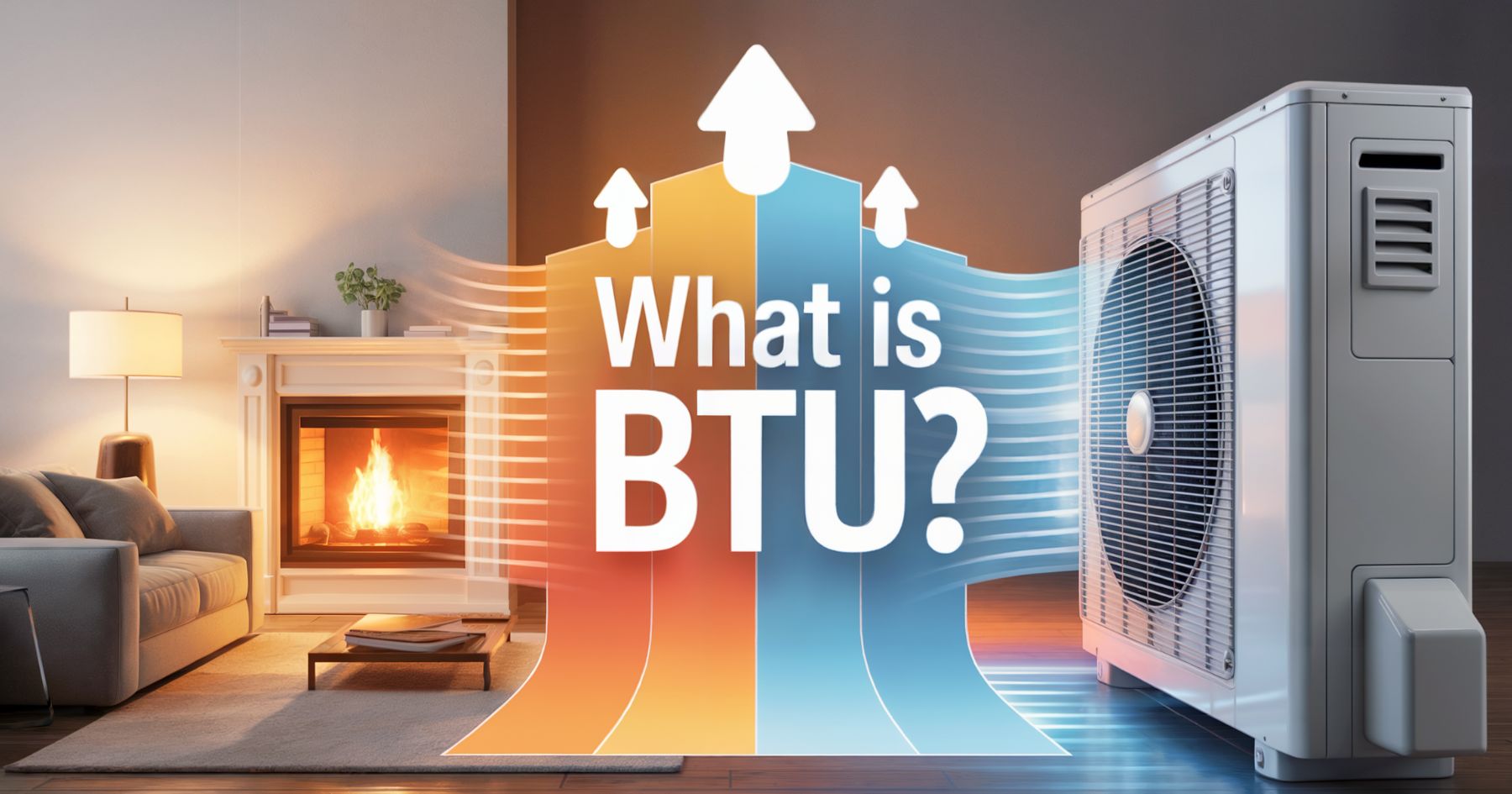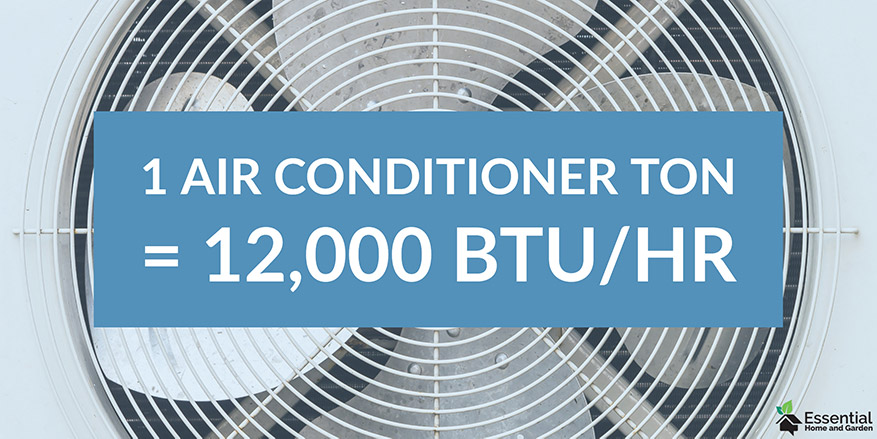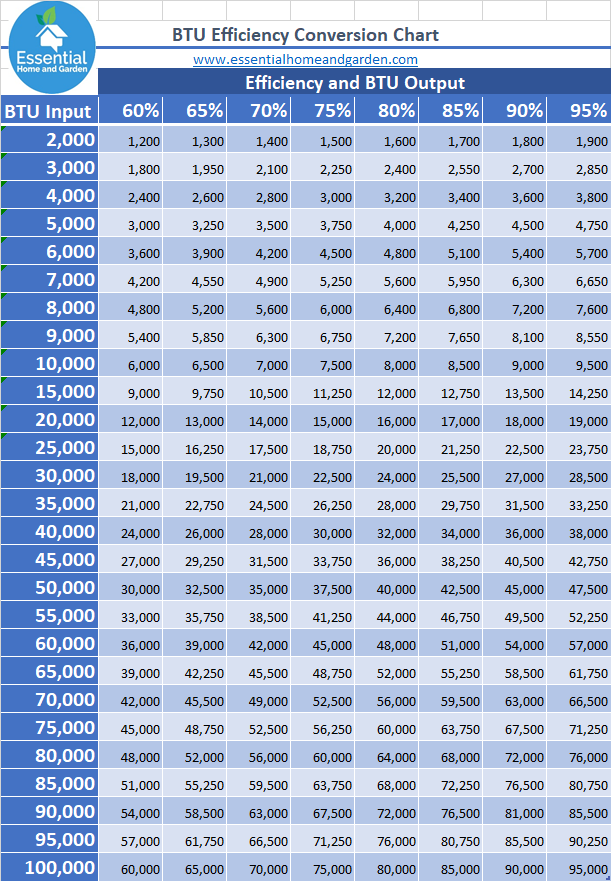If you have ever looked at the specifications of an air conditioner or heater then you have probably noticed the term BTU in the specifications. But what is BTU? What does it stand for? What does it mean?
In this article we will cover all these questions and provide you with valuable conversion charts, calculators and cheat sheets for everything BTU.
The Quick Explanation
- BTU basics: A British Thermal Unit is the heat needed to raise 1 lb / 453g of water by 1 °F / 0.556 °C(≈ 1,055 joules) — it’s a handy “packet” of heat energy.
- BTU/h ↔ kW: HVAC appliances are rated in BTU per hour; divide BTU/h by 3,412 to get kilowatts (e.g., 12,000 BTU/h ≈ 3.5 kW).
- Why it matters: Matching BTU/h to your room size (≈ 20 – 30 BTU per ft²) prevents under-cooling, over-spending on electricity, and premature equipment wear.
BTU to kW Calculator
The Meaning of BTU
BTU stands for British Thermal Units and is a measurement of thermal energy. It was first used in the late 1800s and has since become one of the most common units of classification in heating/cooling appliances.
1 BTU is the energy needed to heat or cool one pound (0.453kg) of water 1 degree Fahrenheit (0.556 °C) at sea level.
BTU In Common Household Products
You will most commonly find it used to measure BTU/hr (BTUs per hour) in heating and cooling appliances but it is also used to measure the effectiveness of many other items.
BTU is used as a unit of classification in:
- Air conditioners
- Pellet Stoves
- Electric heaters
- Oil filled heaters
- Solar hot water heating
- Heating fuel
- Cooking devices
- Gas fire pits
In the below sections I will go over how BTU is used as a unit of specification in these common household items.
What Does BTU Mean In Air Conditioners?
When used as a specification for an air conditioner, the BTU number given refers to the amount of heat that the unit can remove from the air per hour (BTU/hr).
Typical BTU ranges air conditioners are as follows:
- Portable air conditioners: 8,000 – 12,000 BTU
- Split system air conditioners: 9,000 – 36,000 BTU
- Window mounted air conditioners: 3,000 – 25,000 BTU
Central air conditioning units (there is one compressor unit for the whole house) generally use tonnage as a measurement of cooling power instead of BTU. However, to convert between the two is quite simple. 1 air conditioner ton = 12,000 BTU/hr
So a 2-ton central air conditioning system can remove 24,000 BTUs of heat from the air per hour. It should be noted here that air conditioner tonnage has nothing to do with weight.
Bigger Is Not Better
Choosing the right size air conditioner is very important, and bigger is certainly not better.
An air conditioner which is too powerful for the area that needs cooling actually has quite a few downsides:
Too large an air conditioner = More Costs
The most obvious downside to picking an air conditioner that is too large is that you will need to spend more to purchase the unit in the first place.
If the air con unit needs installing, then it is likely that installation costs will also be higher for a more powerful system.
More Wear and Tear
When you use an air conditioner that is too large for the area it is cooling, you will find that the compressor will need to turn on and off much more than it is designed to.
This is due to the fact that a larger unit will indeed cool down an area very quickly, but it will then turn the compressor off. When the temperature rises above the set temperature again it will re-activate. This on-off cycle happens much more frequently with a larger unit and can result in parts wearing out quicker than they otherwise should.
This then leads to increased maintenance costs.
Higher Humidity
If you ask me, the worst type of heat is humid heat. It makes you sticky, sweaty and just feeling yuck overall.
If you choose an air con unit that is too powerful, then you will likely find that the area being cooled is more humid than you may otherwise like.
This is due to the fact that because the compressor is actually off a lot of the time, it doesn’t remove as much moisture from the air as it is designed to do.
Choose The Right Size Air Conditioner
For a single room, use the table below to give you an estimation of the size of the air conditioner required.
| Room Size (Sq Ft) | Recommended BTUs |
|---|---|
| 0-150 | 5,000 |
| 150-200 | 6,000 |
| 250-300 | 8,000 |
| 300-350 | 10,000 |
| 350-400 | 12,000 |
| 400-450 | 14,000 |
| 450-500 | 15,000 |
| 500-600 | 18,000 |
| 600-700 | 20,000 |
| 700-800 | 22,000 |
| 800-900 | 25,000 |
If you are calculating the size of a central air conditioner, then you can use the following tools to help you calculate the right sized unit for your home:
Heaters and Furnaces
Heaters also often use the BTU measurement as a common specification. However, it gets a little more confusing here as the number can be given in two ways:
- BTU Input
- BTU Output
Let’s take a look at the difference between the two:
BTU Input vs BTU Output (Heating Efficiency)
The BTU input is the amount of fuel the heater can consume per hour.
But, it is important to remember that there is no such thing as a 100% efficient heater.
What do we mean by efficiency? Well during the process of consuming the fuel, some of the energy is lost in the process to inefficiencies.
Every heater has an efficiency rating. Sometimes it is given in the specifications, other times it’s not and you will have to ask the manufacturer to provide it.
So a heater that has a BTU input rating of 80,000 BTU and an efficiency rating of 85% puts out about 68,000 BTU per hour.
This is calculated by: (Input BTU x efficiency %)/100
This number is the BTU output specification. And as you can see the two numbers can be quite different. It is very important when choosing a heater that you are aware of the efficiency rating of the product.
E.g. a pellet stove with a BTU input rating of 50,000 and an efficiency rating of 70% actually has a BTU output of 35,000 per hour.
Compare this with a different model pellet stove that has an input rating of 45,000 BTU and an efficiency of 85%. This means that the BTU output is 38,250. Which is actually higher, despite having the lower BTU input rating because of the lower efficiency.
BTU Input – Output Efficiency Calculator
BTU Input – Output Conversion Chart
Choose The Right Size Heater
It is important when choosing a heater, you choose a model that has the right output for your space.
Heaters are most efficient when running on their maximum setting. This means that if you have a heater that is too big for the space, it will need to be turned to a lower setting – resulting in lower heating efficiency.
And visa versa, when a heater is too small it will not be able to heat the space properly and will result in inadequate performance.
Heating Fuels BTU Chart – Cost Comparison Table
So the BTU input for heaters has to come from somewhere right?
Each heater type has a fuel it requires – and that fuel has a BTU rating.
The table below shows the approximate BTU input, output, heating efficiency and heating cost per million BTU.
| Fuel | Unit | BTU Per Unit | Cost Per Unit | Cost per million BTU Input | Average Heater Efficiency % | BTU Output per 1M BTU Input | Cost Per Million BTU Output |
|---|---|---|---|---|---|---|---|
| Electricity | 1 Kilowatt-hour | 3,412.00 | $0.17 | $50.15 | 98 | 980,000 | $51.17 |
| Natural Gas | 1,000 Cubic Foot (cu.ft.) | 1,050,000.00 | $10.91 | $10.39 | 85 | 850,000 | $12 |
| Propane | 1 Gallon | 91,600.00 | $2.71 | $29.59 | 85 | 850,000 | $34.80 |
| Heating Oil | 1 Gallon | 139,000.00 | $3.74 | $26.90 | 80 | 800,000 | $33.63 |
| Kerosene | 1 Gallon | 135,000.00 | $4.50 | $33.33 | 85 | 850,000 | $39.21 |
| Pellets | 1 Ton | 16,500,000.00 | $365 | $22.12 | 80 | 800,000 | $27.65 |
| Wood - air dried | 1 Cord | 20,000,000.00 | $350 | $17.50 | 60 | 600,000 | $29.17 |
Pricing based on 2025 data from https://www.eia.gov
Solar Hot Water Panels
Another device that uses BTU’s as a measurement is solar hot water panels.
The specific measurement used for solar hot water panels is BTU per square foot per day. It may be referred to simply as BTU per day in specifications – but both the numbers are the same measurement.
The higher the BTU number specified, the higher the water heating efficiency.
Gas Stoves and Grills
BTU is used to measure the output of each burner on a gas stove/grill.
A home gas stove will typically put out about 7,000 BTU per hour, but some models will put out as low as 3,000 BTU and as high as 12,000 BTU.
You may find that the specific gas stove or grill you are after advertises either a per burner BTU number or a product-wide BTU.
If the number is product-wide, then simply divide the BTU by the number of burners to get the per burner BTU.
Frequently Asked Questions
Is a higher or lower BTU better?
Neither is “better” in absolute terms: you need the right BTU for the room size and climate. Too high wastes energy and short-cycles the unit, while too low can’t keep the space comfortable and overworks the equipment.
What does 1 BTU stand for?
1 BTU is the energy needed to heat or cool one pound of water 1 degree Fahrenheit at sea level.
How do I convert BTU to watts?
Divide the BTU-per-hour rating by 3.412 to get watts ( e.g., 12 000 BTU/h ≈ 3 517 W ). For instant results, just plug the number into our BTU ⇆ kW/W converter here.




I have a Coleman 2 burner classic camp cook stove that advertised 20,000 btu max for both burners on is there a way to calculate 1 burner on it’s lowest possible setting?
I do this in my small RV with a wood stove fan an a hot plate over the burner.
Works very well compared to my infra red heater on low at 3200 btu which is too much after a while that uses no fan.
Yes i provide proper ventilation and have a CO2 detector.
Would you know what Heating Input 12000BTU/HR*4 means? I’m looking at a gas grill that has four burners but I don’t know if that means each burner individually has 12000BTU or combined. I called for clarification but no ones knows.
I would guess that it means each burner has 12,000 btu.